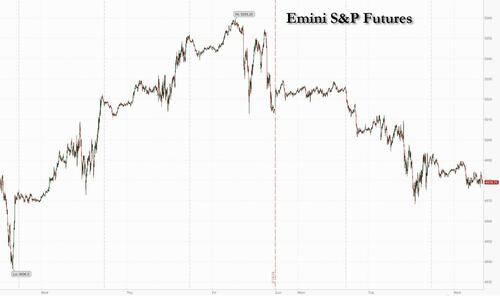


US futures extended their slide, bucking a strong Asian session with European stocks mixed, ahead of what Goldman trader Scott Rubner called “the most important stock on planet earth” - that would be Nvidia for anyone who has been living in a cave the past year - reports after the close facing sky-high expectations, and where another Goldman trader, Peter Callahan, said that the tactical debate is whether this print will be a local top or a ‘break-out’ moment for the stock and for the AI trade (from where he sits, this "feels like consensus is learning more towards the former"). And with options implying the stock may move about 11% in either direction, i.e., a whopping $200BN in market cap may be gained or lost for a company that recently surpassed GOOGL and AMZN in market cap, it's not surprising why the market is on edge. With that preamble out of the way, S&P 500 futures dropped 0.2% as of 7:40am and Nasdaq contracts lost about 0.5%, suggesting Wall Street may be in for a third day of declines. Bond yields are lower, the 10Y dropping 2bps, with steepening across most of the curve; the USD is flat and commodities are weaker. The macro data focus is on Fed Minutes this afternoon; while possible to see a dovish surprise regarding QT this most likely comes at the March 20 Fed meeting where we may see a reduction in the pace of QT.
In premarket trading, Palo Alto Networks plunged more than 20% after the cybersecurity firm cut its forecasts for both revenue and billing and warned of "spending fatigue" among its customers; Piper Sandler downgraded its rating on the stock. Amazon.com rose 1.2% after replacing Walgreens Boots Alliance Inc. in the Dow Jones Industrial Average. Walgreens fell 2.8%. Here are some other notable premarket movers:
Going back to today's main highlight, Nvidia, the stock fell 1.7% in pre-market trading after sliding 4.4% yesterday. “It feels like these earnings today are a barometer of where we are in the global cycle,” said Justin Onuekwusi, chief investment officer at St James’s Place. “Concentration in the stock market has got to levels where one company’s earnings can have a big macro effect. It’s gone beyond being just a portfolio construction issue; it’s a macro challenge which you can’t get away from.”
Meanwhile, Europe’s stock benchmark retreated from near a record high amid disappointing earnings from some of the region’s biggest companies. The Stoxx Europe 600 gauge edged lower 0.1% for a second day, still about four points from its January 2022 peak. Banks were among the leading decliners as HSBC Holdings Plc tumbled more than 7% after reporting an 80% plunge in fourth-quarter profit. Weak earnings from commodities trader Glencore Plc and Rio Tinto Plc, the world’s biggest iron ore miner, weighed on the basic resources sub-index, which slumped to a four-month low. On the positive side, Carrefour SA gained after the French grocer announced a share buy-back, even as quarterly sales disappointed. Here are all the notable European movers:
Positive economic surprises had buoyed European stocks even as traders trimmed bets on interest rate cuts by the European Central Bank. Volatility measures are at historical lows, suggesting some complacency has crept into a market still facing potential headwinds, including rising bond yields, according to Bloomberg Intelligence.
“European stocks could consolidate recent gains in the near term as investor sentiment looks overheated,” BI strategists Laurent Douillet and Tim Craighead wrote in a report. “Rising government bond yields haven’t curbed enthusiasm so far, as highly leveraged companies slightly outperform, and remain a key 2024 risk for equities.”
Earlier in the session, Asian stocks erased an early loss and edged higher as China rallied after authorities rolled out more measures to restore investor confidence, offsetting broader weakness ahead of Nvidia’s earnings. The MSCI Asia Pacific Index rose 0.1% after falling as much as 0.5% earlier, driven by gains in Chinese tech giants including Tencent and Alibaba. Miners dragged on the gauge as iron ore extended declines amid concerns about demand outlook in China, while chip-related stocks declined in Taiwan, South Korea and Japan. Chinese benchmarks jumped, with a gauge of offshore-listed shares surging more than 3% in Hong Kong, as the nation’s two bourses vowed to tighten supervision of quantitative trading after imposing a freeze on a major fund’s accounts. Bloomberg also reported that China has banned major institutional investors from reducing equity holdings at the open and close of each trading day, part of the government’s most forceful attempt yet to prop up the nation’s $8.6 trillion stock market. Banks meanwhile ramped up funding help for the troubled property sector.
In FX, the Bloomberg Dollar Spot Index is little changed after posting a small drop for two straight days; one-year risk reversals in the Bloomberg Dollar Spot Index closed yesterday at the least bullish level in eight months. Markets are close to fully discounting a 25bps cut in June, and see a 33% chance of a cut in May.
In rates, Treasuries are slightly richer across the curve with gains led by front-end, where 2-year yields are lower by ~2bp vs Tuesday’s close. Treasury 10-year yields around 4.26%, richer by around 1.5bp on the day, outperforming bunds and gilts by 2bp and 3bp in the sector. Front-end-led gains in Treasuries steepen 2s10s, 5s30s curves by 0.5bp and 0.7bp, with both spreads off session wides. Bunds lag as the market digests German 10-year auction, while gilts give back a portion of Tuesday’s aggressive rally. US session includes 20-year bond auction, January FOMC minutes and Nvidia Corp. results, scheduled to be reported after the close. Corporate new-issue calendar is said to be under consideration for a large offering. Treasury auctions resume with $16b 20-year bond sale at 1pm; the WI level around 4.535% is above auction stops since November and ~11bp cheaper than January’s, which tailed by 0.8bp.
In commodities, aluminum surged on speculation that a fresh wave of US sanctions against Russia may target the metal, potentially disrupting supplies. Iron ore futures hit the lowest since October after a volatile session in which prices flipped between gains and losses. Oil edged lower with WTI falling 0.7% to trade near $76.50. Spot gold rises 0.2%.
In crypto, Bitcoin (-1.3%) fell back below USD 52k, and Ethereum (-2.2%) dips back under 3k after briefly breaking out above.
US economic data calendar includes only MBA mortgage applications, which declined 10.6% as interest rates rose. Federal Reserve members scheduled to speak include Bostic (8am), Barkin (9:10am) and Collins (5:30pm). FOMC minutes from Jan. 30-31 meeting are due to be released at 2pm
Market Snapshot
Top Overnight News
A more detailed look at global markets courtesy of Newsquawk
APAC stocks traded mixed with headwinds following the tech-led declines stateside ahead of Nvidia earnings and FOMC Minutes. ASX 200 was dragged lower by consumer stocks and miners in another busy day of earnings. Nikkei 225 continued its gradual pullback from near-record levels but remained above the 38,000 level. Hang Seng and Shanghai Comp. shrugged off early weakness with outperformance in Hong Kong driven by strength in property and tech, while the mainland also recovered its initial losses and more following recent stability efforts by Chinese authorities.
Top Asian News
European bourses, Stoxx600 (-0.1%) are mixed with a slight positive bias, following on from a similar APAC handover. FTSE 100 (-0.8%) underperforms, hampered by significant losses in index heavyweights. European sectors are on a mixed footing; Autos outperform with broad-based gains within the sector. Basic Resources is at the foot of the pile, weighed on by Glencore (-5.5%) and Rio Tinto (-2.1%) following poorly received earnings. Banks are also lower, after softer HSBC (-7.1%) results. US Equity Futures (ES -0.2%, NQ -0.4%, RTY -0.2%), are modestly in the red, continuing the losses seen in the prior session. Nvidia (-1.7%) is softer in the pre-market, ahead of earnings. In terms of pre-market movers; Amazon (+1.0%) and Uber (+0.6%) are firmer, after S&P Dow Jones Indices said they are set to join the DJIA and DJTA respectively.
Top European News
Earnings
FX
Fixed Income
Commodities
Geopolitics: Middle East
Geopolitics: Other
US Event Calendar
Central Bank speakers
DB's Jim Reid concludes the overnight wrap
One of the proudest moment of my career arrived in the last 24 hours as after 29 years of having a Bloomberg terminal, I found out that I breached their monthly download limit for the first time and was locked out. Before I apply for a pay rise based on my increased productivity, I can only think it's because of the colossal spreadsheets that were involved in the making of the Mag-7 chartbook where Galina in my team and I worked out the profitability of every listed stock in every G20 country and amalgamated them to compare with the Mag-7. A quick call to their help desk and my account was thankfully restored.
Between publishing the above chart book 9 days ago and now, Nvidia has gone from being the 5th largest company in the US to initially the 4th and then the 3rd largest but yesterday it slipped back to the 5th again as it fell -4.35% ahead of a very important earnings release today. This was the worst daily performance since last October. However implied options suggest that that the post results move is priced to be 10.5% in either direction so stand by for potential fireworks across markets in either direction. After having said that they'll probably end up being flat in after-hours trading by tomorrow's EMR!
This move contributed to the S&P 500 (-0.60%) losing ground with the Mag-7 (-1.46%) and the Nasdaq (-0.92%) underperforming. Small caps also lost significant ground, with the Russell 2000 (-1.41%) moving back into the red year-to-date. To be fair, most sectors within the S&P 500 posted pretty modest declines, and the equal-weighted S&P 500 saw a moderate -0.31% decline with 197 advancers. That included a strong performance for Walmart (+3.23%), which was the fifth best performer in the index after their earnings beat estimates. And over in Europe, it was much the same story, with technology stocks helping to drag the broader indices lower, as the STOXX Technology Index fell -1.93%, even though the STOXX 600 (-0.10%) only experienced a marginal decline. Moreover in France, the CAC 40 (+0.34%) hit a new all-time high.
In the meantime, sovereign bonds got support from more dovish news over the last 24 hours, as the Canadian CPI print for January surprised on the downside. That was welcome news for investors, as recent prints from the US and Sweden had seen upside surprises, which added to fears that the path back to target was likely to prove a bumpy one. So with Canadian headline inflation down to +2.9% (vs. +3.3% expected), and core inflation also falling, that led to growing expectations that the Bank of Canada would soon be able to cut rates. Indeed, the chance of a rate cut by June surged from 58% on Monday to 84% by the close yesterday, and yields on 10yr Canadian government bonds fell -7.1bps.
That backdrop helped support a global sovereign bond rally. There were modest declines in Treasury yields, with the 10yr down -0.5bps to 4.28%, and 2yr down -3.0bps. The bond rally was slightly stronger in Europe, where yields on 10yr bunds (-3.8bps), OATs (-3.6bps) and BTPs (-4.2bps) all fell back. And it was UK gilts (-6.9bps) that saw one of the biggest moves after comments from BoE Governor Bailey. He said that they “ don’t need obviously inflation to come back to target before we cut interest rates. I must be very clear on that, that’s not necessary ”. In addition, Bailey also said he was “comfortable with a profile that has cuts in it”, suggesting that the next move was likely to be a rate cut. In turn, investors became more confident in the likelihood of a cut by June, with the chance up to 66% by the close from 52% the day before.
Otherwise on the inflation side, there was better news from the latest commodity declines, with Brent oil prices (-1.46% to $82.34) falling back from their 3-month high the previous day. At the same time, there was a notable decline in iron ore futures (-2.01%), which hit a 3-month low amidst ongoing concern about demand from China. The Bloomberg commodity index declined by -0.44%, although it stayed half a percent above its 2-year lows seen last week.
Chinese stocks are bucking the global trend this morning as actions to boost sentiment are winning out for now. The Hang Seng (+2.40%) is off its highs but with the CSI (+2.30%) and the Shanghai Composite (+2.13%) catching up after the lunch break.
Other Asian markets are lower with the Nikkei (-0.24%), KOSPI (-0.32%) and the S&P/ASX 200 (-0.66%) trading lower alongside S&P 500 (-0.13%) and NASDAQ 100 (-0.27%) futures. 2yr and 10yr US treasuries are -2.3bps and -0.6bps lower respectively.
Early morning data showed that Japan’s exports rose for the second consecutive month advancing +11.9% y/y in January (v/s +9.5% expected and against a +9.7% downwardly revised increase in December) on higher demand for cars and semiconductor-manufacturing equipment. Imports fell -9.6% y/y, versus Bloomberg’s estimate for an -8.7% decrease. As such the trade deficit of -1.758 trillion yen was slightly smaller than the -1.855 trillion yen expected.
There wasn’t too much data yesterday, although the US Conference Board’s Leading Index fell for a 22nd consecutive month in January, with a -0.4% decline (vs. -0.3% expected).
To the day ahead now, and an important highlight will be Nvidia’s earnings after the US close. Otherwise from central banks, we’ll get the FOMC’s minutes from the January meeting, and hear from the Fed’s Bostic and the BoE’s Dhingra. Data releases include Euro Area consumer confidence for February.


